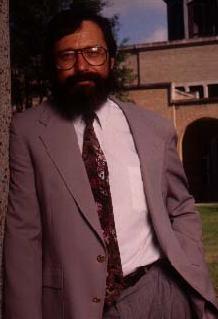
Spring/Summer 1999
Volume 6, Issue 2
Spring/Summer 1998
Volume
3, Issue 1
January 1995
Volume
2, Issue 4
October 1994
Volume
2, Issue 1
January 1994
Danny Sorensen
Professor and Chair of Computational and Applied Mathematics, Rice University
Danny Sorensen works in the general area of numerical analysis. His current research involves the design, analysis, and computer implementation of algorithms for solving fundamental problems in linear algebra. The primary focus of this research is on very large-scale eigenvalue problems.
Developing, analyzing, and implementing algorithms for large eigenvalue problems has become a very active area of research today, because they can be useful in a wide variety of scientific and engineering applications. "Eigenvalue problems arise in everything from semiconductor device modeling, semiconductor laser diode design, and nano-scale technology, to applications in chemical engineering, computational chemistry, and computational biology," says Sorensen. "For example, the software resulting from this research is being used in computational biology for the analysis and data compression of molecular dynamics trajectories, and three-dimensional reconstructions of virus images from two-dimensional projections obtained from electron micrographs."
Sorensen and his colleagues have recently developed ARPACK, a software package for solving large-scale symmetric, nonsymmetric standard, or generalized eigenvalue problems. Industrial-scale problems with as many as one million degrees of freedom have been solved with this package. This package is currently regarded as the best software available for these problems on both parallel and standard computing systems. "This has been an exciting project because it began with an idea I call 'Implicit Restarting' and has been completely developed here at Rice University from the initial theory to the public domain software. This could not have happened without the CRPC structure. We are continually working to improve the algorithms and the software and we are always looking for new applications."
Sorensen earned his B.S. in mathematics at the University of California at Davis (1972), and his M.A. and Ph. D. in mathematics at the University of California at San Diego (in 1975 and 1977, respectively). He began his career as an assistant professor of mathematics at the University of Kentucky, then in 1980 joined the Mathematics and Computer Science Division of Argonne National Laboratory. There, Sorensen became a senior computer scientist and was one of the founders of Argonne's Advanced Computing Research Facility before becoming a faculty member of Rice University in 1989.
Sorensen heads the Computational and Science Engineering (CSE) Graduate Program at Rice. Established in 1992, the program offers degrees in computational science at both the master's and Ph.D. levels. Students learn methods in parallel-vector processing, scientific visualization, networking, compiler technology, programming environments, parallel algorithms, numerical methods, and modeling with an emphasis on a particular area in science or engineering. Richard Lehoucq, the first graduate of the program (June 1995), was awarded the 1995 J. H. Wilkinson Fellowship in Scientific Computing at Argonne National Laboratory.
This year, Sorensen chaired the Society for Industrial and Applied Mathematics (SIAM) annual meeting, held October 23-27 in Charlotte, NC. CSE was the main theme of that meeting and was a showcase for the potential of computational science.
Table of Contents
